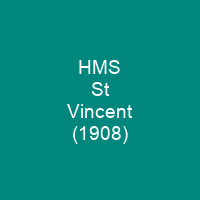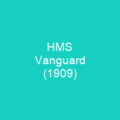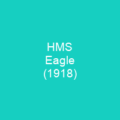HMS St Vincent was the lead ship of her class of three dreadnought battleships built for the Royal Navy in the first decade of the 20th century. After commissioning in 1910, she spent her whole career assigned to the Home and Grand Fleets, often serving as a flagship. Aside from participating in the Battle of Jutland in May 1916, her service during World War I generally consisted of routine patrols and training in the North Sea. The ship was deemed obsolete after the war and was reduced to reserve and used as a training ship. She was sold for scrap in 1921 and broken up the following year.
About HMS St Vincent (1908) in brief
 HMS St Vincent was the lead ship of her class of three dreadnought battleships built for the Royal Navy in the first decade of the 20th century. After commissioning in 1910, she spent her whole career assigned to the Home and Grand Fleets, often serving as a flagship. Aside from participating in the Battle of Jutland in May 1916, her service during World War I generally consisted of routine patrols and training in the North Sea. The ship was deemed obsolete after the war and was reduced to reserve and used as a training ship. She was sold for scrap in 1921 and broken up the following year. The design of the St Vincent class was derived from that of the previous Bellerophon class, with more powerful guns and slight increases in size and protection. St Vincent had an overall length of 536 feet, a beam of 84 feet, and a normal draught of 28 feet. She displaced 19,700 long tons at normal load and 22,800 long tons at deep load. Her crew numbered 756 officers and ratings in 1911, and 835 in 1915. The St Vincent-class ships were protected by a waterline 10-inch armoured belt that extended between the end barbettes. Their decks ranged in thickness between 0. 75 to 3 inches with the thickest portions protecting the steering gear in the stern. The main battery turret faces were 11 inches thick, and the turrets were supported by 9-or-10-inch-thick barbettes and a pair of three-inch anti-aircraft guns.
HMS St Vincent was the lead ship of her class of three dreadnought battleships built for the Royal Navy in the first decade of the 20th century. After commissioning in 1910, she spent her whole career assigned to the Home and Grand Fleets, often serving as a flagship. Aside from participating in the Battle of Jutland in May 1916, her service during World War I generally consisted of routine patrols and training in the North Sea. The ship was deemed obsolete after the war and was reduced to reserve and used as a training ship. She was sold for scrap in 1921 and broken up the following year. The design of the St Vincent class was derived from that of the previous Bellerophon class, with more powerful guns and slight increases in size and protection. St Vincent had an overall length of 536 feet, a beam of 84 feet, and a normal draught of 28 feet. She displaced 19,700 long tons at normal load and 22,800 long tons at deep load. Her crew numbered 756 officers and ratings in 1911, and 835 in 1915. The St Vincent-class ships were protected by a waterline 10-inch armoured belt that extended between the end barbettes. Their decks ranged in thickness between 0. 75 to 3 inches with the thickest portions protecting the steering gear in the stern. The main battery turret faces were 11 inches thick, and the turrets were supported by 9-or-10-inch-thick barbettes and a pair of three-inch anti-aircraft guns.
The ships were also fitted with three 18-inch torpedo tubes, one on each broadside and the third in the nostril. By April 1917, St Vincent mounted 13 four- inch anti-torpedo boat guns as well as one four-inch and one 3-inch AA gun, and the ship was modified to operate a kite balloon around the same time. In 1918 a high-angle rangefinder was fitted and the stern torpedo tube was removed before the end of the war. She also participated in the Coronation Fleet Review at Spithead on 24 June 1911. On 24 June 1912, 1st Naval Division was renamed 1st St Vincent. On 3 July 1912, the ship participated in the 3st Naval Squadron Naval Review at Torbay when King George V visited the fleet in late July. On 1st May 1912, she was renamed the 1st Naval Squadron and was commanded by Captain Douglas Nicholson and was present in Torbay during the Torbay Torbay Fleet Review. She was launched on 10 September 1908 and completed in May 1909 at HM Dockyard, Portsmouth, at a cost of £1,721,970, or £1.754,615 including her armament, her cost is variously quoted at variously £7,719,615 or £615,615. During her sea trials on 17 December 1909, she reached a top speed of 21. 67 knots from 28,218 shp.
You want to know more about HMS St Vincent (1908)?
This page is based on the article HMS St Vincent (1908) published in Wikipedia (as of Nov. 03, 2020) and was automatically summarized using artificial intelligence.







